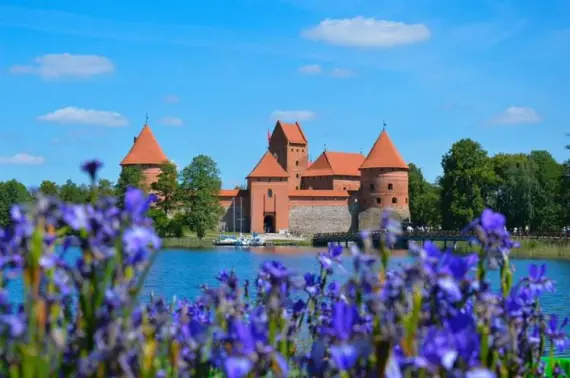Vilnius - the eclectic capital of Lithuania
VILNIUS

Wilno- called "little Rome," is the largest Baroque city north of the Alps. It is the capital of Lithuania and one of its most important cities. Founded in 1323, it remained in the orbit of Polish influence for years. To date, it is treated with great sentiment by many Poles.
Vilnius is an important educational center. Vilnius University was founded in the 16th century by King Stefan Batory, making it one of the oldest universities in Eastern Europe. This city is also of great importance for Catholics. It houses the famous Ostra Brama Chapel (known as the Gates of Dawn), to which the faithful make pilgrimages not only from Lithuania, but also, and perhaps especially, from Poland. But there are as many as 40 churches in Vilnius. There are numerous traces of great Poles. Marshal Pilsudski's heart is buried in the famous Ross Cemetery. Vilnius also has a lot of other interesting sights and great walking areas. And the sunset admired from the Trzykrzyska Hill is memorable for a long time.
Vilnius offers quite a few attractions, especially religious monuments, museums and viewpoints. A huge plus is that most of them can be seen simply by walking around this beautiful city.
You should start your sightseeing with Vilnius' UNESCO-listed Old Town. The centerpiece of the Old Town is the Cathedral Square with its unusual, as it is a classicist, cathedral. To the east of it rise Gediminas Tower and Trinity Hill.
It's worth at least a short visit to the Archcathedral Basilica of St. Stanislaus the Bishop and St. Ladislaus and see the beautiful Royal Chapel where the tombs of Alexander Jagiellon and Barbara Radziwill are located. The chapel is considered a masterpiece of Baroque art.
One of the most interesting sights in the central part of Vilnius is the University Complex. After buying tickets, you can walk through the historic courtyard and enter the Church of St. John the Baptist and St. John the Apostle. The temple has retained some of its Baroque furnishings, and a curiosity is the 19th-century monuments dedicated to famous Poles (including Adam Mickiewicz and Tadeusz Kosciuszko).Of the former residences erected by the magnates of the Polish-Lithuanian Commonwealth, the Radziwill Palace and the Sapieha Palace in Antokol have survived The renovated part of the Radziwill Palace houses the Lithuanian Museum of Art (it resumed its activities in 2020), while the Sapieha Palace houses the Center for Contemporary Art. The Pacas Palace is home to the Embassy of the Republic of Poland in Lithuania.
In the south of the city is the Ostra Brama (Gates of Dawn). In its window is the image of Our Lady of Ostra Brama, which was held in special reverence among the Polish population. It was mentioned by Adam Mickiewicz in his invocation to "Pan Tadeusz." The gate itself was built in the 16th century, as part of the defensive walls.
The artistic district of Vilnius - Užupis - is also a must-see. This district has declared itself the Republic of Užupis. It has its own flag, constitution (with the right to be lazy or love and care for a cat), and even an army. The district attracts artists, whose studios are spread both along the river and from buildings far from its banks. There is a unique atmosphere there, and the pubs tempt with an alternative vibe.
Mount Trzykrzyska is one of the most popular vantage points in the Lithuanian capital. On its summit actually rise three, white crosses. From here you can enjoy a beautiful and very extensive panorama of Vilnius.
The Ross Cemetery was founded in the second half of the 18th century, making it the oldest necropolis in Vilnius. It currently covers an area of almost 11 hectares. Many prominent figures from the world of politics, culture and art, both from Lithuania and Poland, are buried there. Among those who have their graves here are the mother of Jozef Pilsudski, who is buried here with her son's heart; Ludwik Kondratowicz, Antoni Wiwulski and many others. Rossa is a unique place, as it encompasses a slightly hilly area covered with old-growth forest. The historic tombstones and chapels are incredibly impressive. This is one of the most interesting places for a walk in Vilnius.
The bus stop is located at Bus stotis, Sodu g.22 and change, platforms 34.
You are welcome to board our buses!
Are you interested in the description of the city? Check the details of connections to Chorol from your town in the search engine at stronie głównej.
VILNIUS - list of coach stops:
- Autobusu stotis, Sodu g.22
- Dw. autobusowy stan. 34, ul. Sodu g.22
- Dworzec Autobusowy stan.22, ul. Sodu g.22
- Dworzec Autobusowy stan.22, ul. Sodu g.22
- Dworzec Autobusowy stan.22, ul. Sodu g.22
- Dworzec Autobusowy stan.36, ul. Sodu g.22
- Dworzec Autobusowy stan.37, ul. Sodu g.22
- Autobusu stotis, Sodu g.22
Stops of other carriers:
VILNIUS - list of international connections:
© 2025 Sindbad
Technical support, assistance, payments: Sindbad IT
© 2025 Sindbad
Technical support, assistance, payments: Sindbad IT
